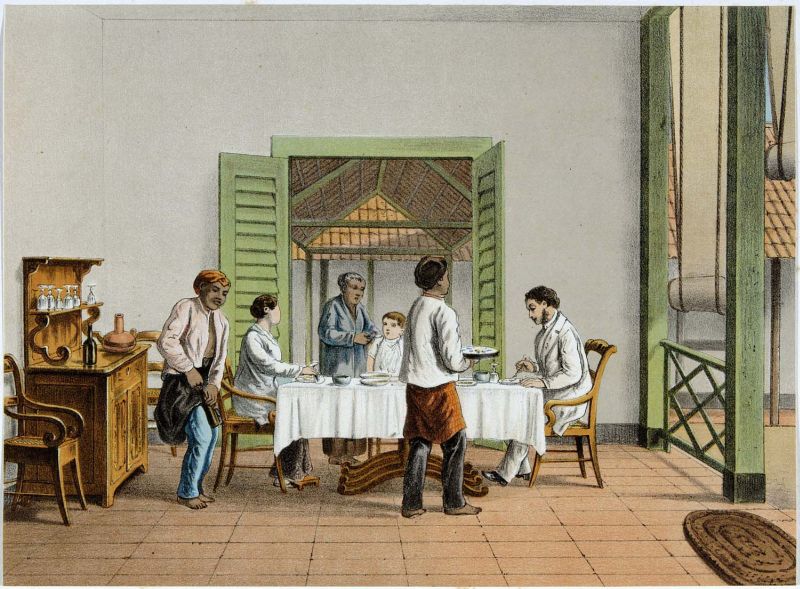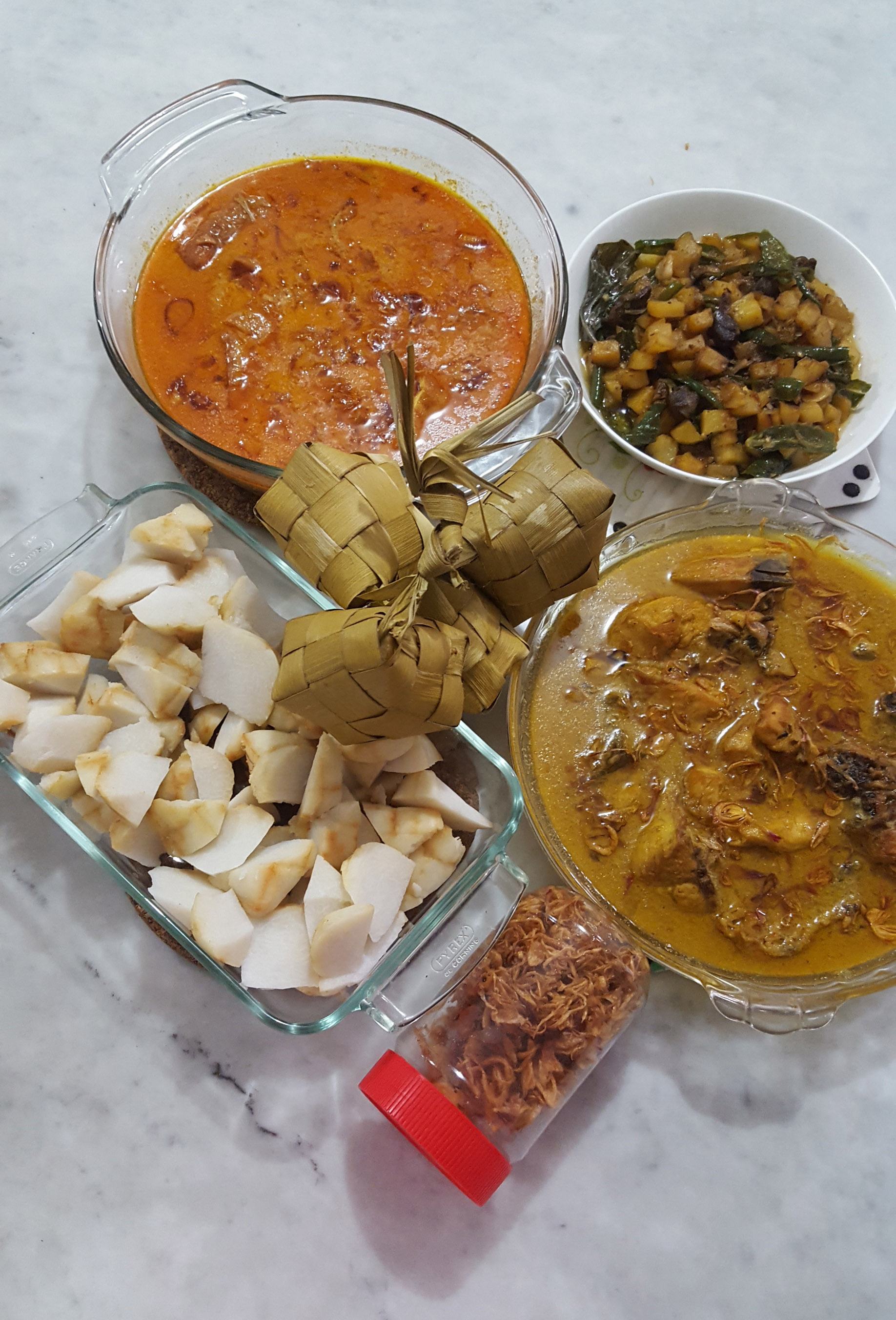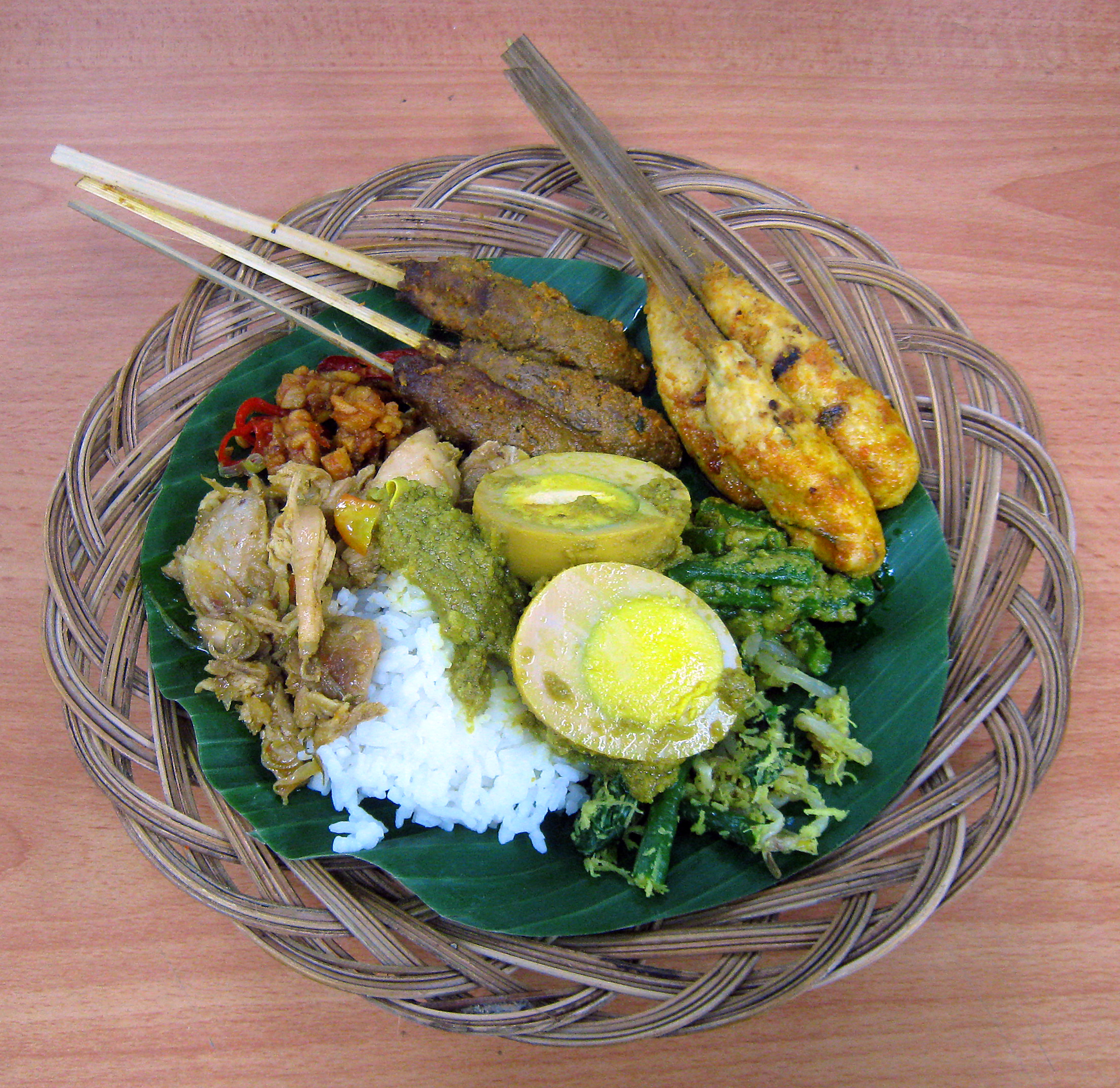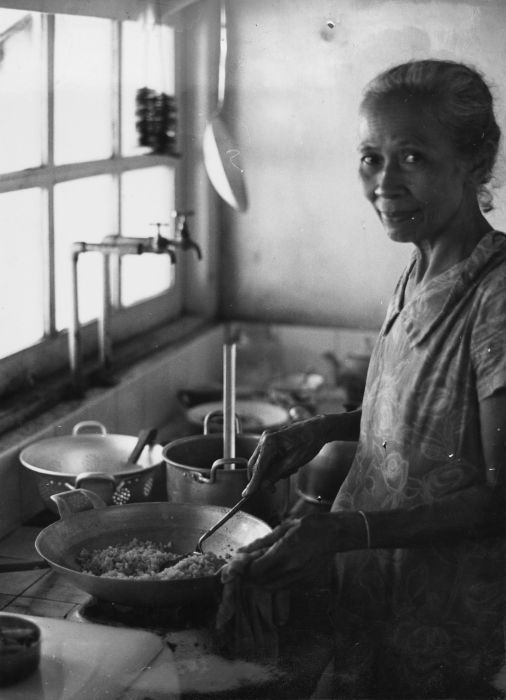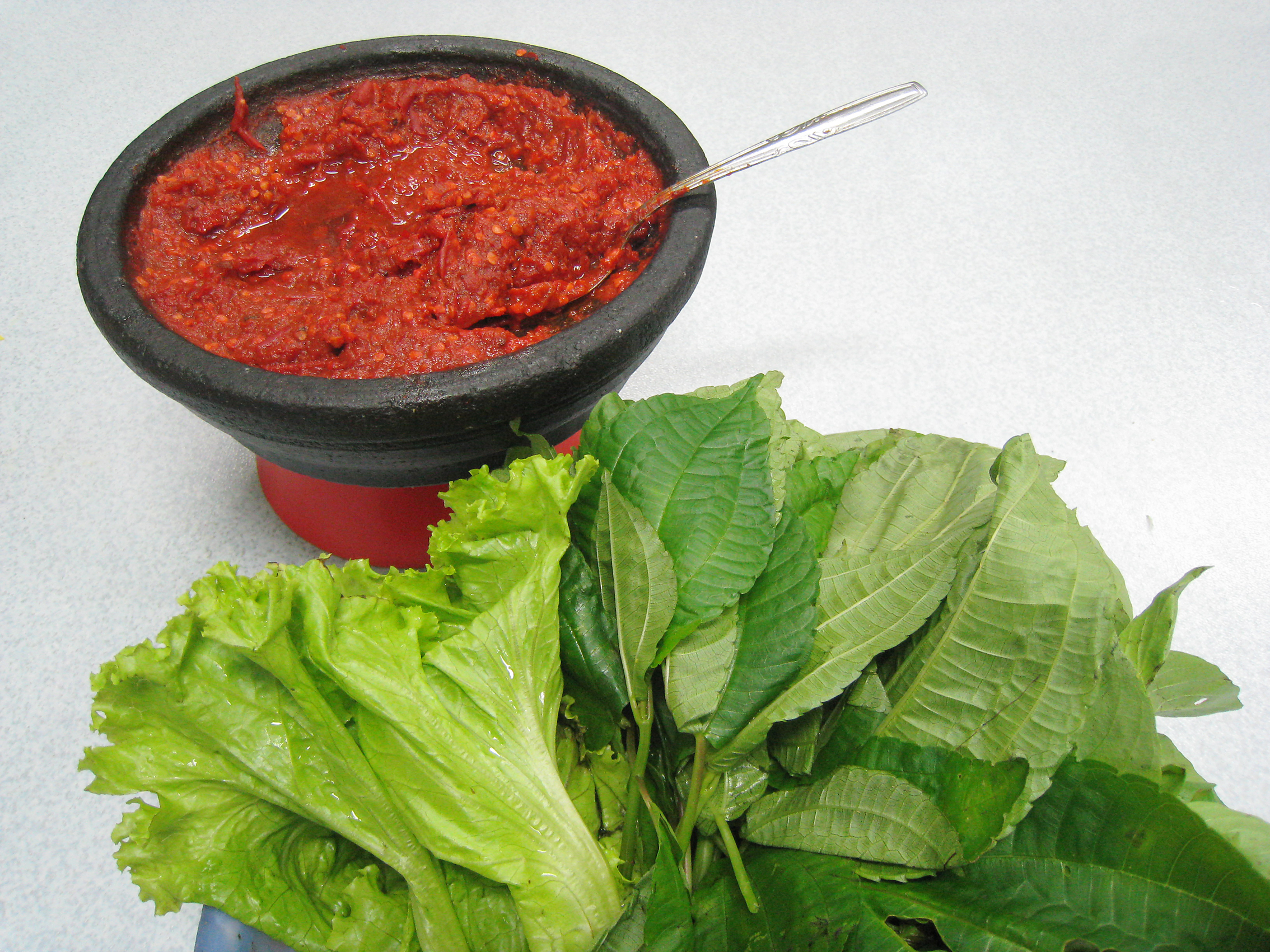|
Rijsttafel
( , ), a Dutch word that literally translates to "rice table", is an Indonesian elaborate meal adapted by the Dutch following the ''hidang'' presentation of '' nasi padang'' from the Padang region of West Sumatra. It consists of many (forty is not an unusual number) side dishes served in small portions, accompanied by rice prepared in several different ways. Popular side dishes include egg rolls, sambals, satay, fish, fruit, vegetables, pickles, and nuts. In most areas where it is served, such as the Netherlands, and other areas of strong Dutch influence (such as parts of the West Indies), it is known under its Dutch name. Although the dishes served are undoubtedly Indonesian, the ''rijsttafel''’s origins were colonial. The Dutch introduced the rice table not only so they could enjoy a wide array of dishes at a single sitting but also to impress visitors with the exotic abundance of their colony. ''Rijsttafels'' strive to feature an array of not only flavors and colors ... [...More Info...] [...Related Items...] OR: [Wikipedia] [Google] [Baidu] |
Indonesian Cuisine
Indonesian cuisine is a collection of various regional culinary traditions by various ethnic groups that formed in the archipelagic nation of Indonesia. There are a wide variety of recipes and cuisines in part because Indonesia is composed of approximately 6,000 populated List of islands of Indonesia, islands of the total 17,508 in the world's largest archipelago,"Indonesian Cuisine." . Accessed July 2011. Tradition and characteristics Indonesia has around 5,350 traditional recipes, with 30 of them ...[...More Info...] [...Related Items...] OR: [Wikipedia] [Google] [Baidu] |
Nasi Campur
Nasi campur (Indonesian language, Indonesian and Malay language, Malay for 'mixed rice'; ), also known as nasi rames () or sego campur (; ) in Java, refers to an Indonesian cuisine, Indonesian and Malay cuisine, Malay dish of a scoop of ''nasi putih'' (steamed rice, white rice) accompanied by small portions of several other dishes, including meats, vegetables, peanut, peanuts, eggs, and fried-shrimp krupuk. Depending on the origin, a nasi campur vendor might serve several side dishes, including vegetables, fish, and meats. It is a staple meal from Indonesia, Malaysia, Singapore, Brunei, and southern Thailand, and also popular in the Netherlands through its colonial ties with Indonesia. This concept has parallels across Asia and the Pacific islands, Pacific: in Thailand, it is known as khao kaeng (), and in Vietnam as cơm bình dân. In the Philippines, the carinderia offers a similar meal style, and in Japan, it is called ''ichijū-sansai''. Similarly, in Hawaii, it is known ... [...More Info...] [...Related Items...] OR: [Wikipedia] [Google] [Baidu] |
The Hague
The Hague ( ) is the capital city of the South Holland province of the Netherlands. With a population of over half a million, it is the third-largest city in the Netherlands. Situated on the west coast facing the North Sea, The Hague is the country's administrative centre and its seat of government, and has been described as the country's ''de facto'' capital since the time of the Dutch Republic, while Amsterdam is the official capital of the Netherlands. The Hague is the core municipality of the COROP, Greater The Hague urban area containing over 800,000 residents, and is also part of the Rotterdam–The Hague metropolitan area, which, with a population of approximately 2.6 million, is the largest metropolitan area of the Netherlands. The city is also part of the Randstad region, one of the largest conurbations in Europe. The Hague is the seat of the Cabinet of the Netherlands, Cabinet, the States General of the Netherlands, States General, the Supreme Court of the Neth ... [...More Info...] [...Related Items...] OR: [Wikipedia] [Google] [Baidu] |
West Indies
The West Indies is an island subregion of the Americas, surrounded by the Atlantic Ocean, North Atlantic Ocean and the Caribbean Sea, which comprises 13 independent island country, island countries and 19 dependent territory, dependencies in three archipelagos: the Greater Antilles, the Lesser Antilles, and the Lucayan Archipelago. The subregion includes all the islands in the Antilles, in addition to The Bahamas and the Turks and Caicos Islands, which are in the Atlantic Ocean, North Atlantic Ocean. The term is often interchangeable with "Caribbean", although the latter may also include coastal regions of Central America, Central and South American mainland nations, including Mexico, Belize, Honduras, Panama, Colombia, Venezuela, French Guiana, Guyana, and Suriname, as well as the Atlantic Ocean, Atlantic island nation of Bermuda, all of which are geographically distinct from the three main island groups, but culturally related. Terminology The English term ''Indie'' is deri ... [...More Info...] [...Related Items...] OR: [Wikipedia] [Google] [Baidu] |
Krupuk
' (Javanese language, Javanese) is an Indonesian cuisine, Indonesian deep frying, deep-fried Cracker (food), cracker made from starch and other ingredients that serve as flavouring. They are a popular snack in parts of Southeast Asia, but are most closely associated with Indonesian cuisine, Indonesia. ''Kroepoek'' also can be found in the Netherlands, through their Dutch East Indies, historic colonial ties with Indonesia. Etymology ''Krupuk'' in Javanese language, Javanese means "fried side dish" (made of flour, mixed with other ingredients). The word was later absorbed into other languages and stylized according to local pronunciations. In Indonesia, Brunei, Malaysia, Thailand, Singapore, and the Philippines, ''krupuk'' is known under a general name with minor phonetic variations. It is called "" in Indonesian, while in Malay, it is "". In Dutch, it is "'" ("oe" being equivalent to "u"), which was also the Van Ophuijsen Spelling System, original spelling prior to the estab ... [...More Info...] [...Related Items...] OR: [Wikipedia] [Google] [Baidu] |
Soto Ayam
Soto ayam is a traditional Indonesian dish with ingredients such as chicken, ''lontong'', noodles, and rice vermicelli. Soto ayam is also popular in Singapore, Malaysia and Suriname, where it is made with slightly different ingredients and known as saoto. Turmeric is added as one of its main ingredients which makes the yellow chicken broth. It is one of the most popular variants of '' soto'', a traditional soup commonly found in Indonesian cuisine. Besides chicken and vermicelli can also be served with hard-boiled eggs, slices of fried potatoes, and Chinese celery leaves. Fried shallots are usually added as a garnish. Coconut milk (''santan'') is also used as an additional ingredient. ''Koya'', a powder of mixed prawn crackers with fried garlic, or sambal is a common topping. ''Krupuk'' or '' emping'' is also a common topping. Lalapan is usually served as a side dish. Variations Different regions have their variation of this dish, for instance: * Soto Ambengan, originated fr ... [...More Info...] [...Related Items...] OR: [Wikipedia] [Google] [Baidu] |
Nasi Goreng
''Nasi goreng'' (English pronunciation: ), (Indonesian language, Indonesian and Malay language, Malay for 'fried rice') is a Southeast Asian rice dish with pieces of meat and vegetables added. It can refer simply to fried pre-cooked rice, a meal including stir frying, stir-fried rice in a small amount of cooking oil or margarine, typically spiced with ''kecap manis'' (sweet soy sauce), shallot, garlic, ground shrimp paste, tamarind and chili pepper, chilli and accompanied by other ingredients, particularly egg (food), egg, Chicken as food, chicken and prawns. ''Nasi goreng'' is sometimes described as Cuisine of Indonesia, Indonesian stir-fried rice, in other sources, it is also referred to as Malaysian cuisine, Malaysian fried rice. The dish is widely enjoyed in various parts of Southeast Asia, including in Bruneian cuisine, Brunei and Singaporean cuisine, Singapore, where it holds cultural significance comparable to that in Indonesia and Malaysia. Nasi goreng has expanded beyo ... [...More Info...] [...Related Items...] OR: [Wikipedia] [Google] [Baidu] |
Gulai
Gulai is a type of spiced stew commonly found in the culinary traditions of Indonesia, Malaysia and other parts of Maritime Southeast Asia, including Brunei, Singapore and southern Thailand. Closely associated with both Minangkabau and Malay cuisines, it is characterised by a rich, aromatic sauce made from coconut milk and a blend of ground spices, typically including turmeric, coriander, chilli and other local aromatics. ''Gulai'' is usually prepared with meat, fish, offal or vegetables and is typically served with rice. In English, it is sometimes described as Indonesian curry or Malay curry. The origins of ''gulai'' can be traced to Indian culinary influences introduced through maritime trade routes across the Indian Ocean. Over time, these foreign elements were adapted to local tastes with the incorporation of regional ingredients such as lemongrass, galangal, ginger and candlenut. This fusion gave rise to a distinctive style of curry-like stew in Maritime Southeast As ... [...More Info...] [...Related Items...] OR: [Wikipedia] [Google] [Baidu] |
Rendang
Rendang is a fried meat or dry curry made of meat stewed in coconut milk and spices, widely popular across Brunei, Indonesia, Malaysia, Singapore, and the Philippines, where each version is considered local cuisine. It refers to both a cooking method of frying and the dish cooked in that way. The process involves slowly cooking meat in spiced coconut milk in an uncovered pot or pan until the oil separates, allowing the dish to fry in its own sauce, coating the meat in a rich, flavorful glaze. Rooted in Malay and Minangkabau, rendang developed at the cultural crossroads of the Malacca Strait. The dish carries strong Indian influences, as many of its key ingredients are staples in Indian cooking. The introduction of chili peppers by the Portuguese through the Columbian exchange after the capture of Malacca in 1511, played a key role in the evolution of rendang. Malay and Minangkabau traders frequently carried rendang as provisions, allowing the dish to travel naturally through c ... [...More Info...] [...Related Items...] OR: [Wikipedia] [Google] [Baidu] |
Priangan
Parahyangan () or Priangan (Sundanese script: ) is a cultural and mountainous region in West Java province on the Indonesian island of Java. Covering a little less than one-sixth of Java, it is the heartland of Sundanese people and their culture. It is bordered to the West by Banten province, to the North by the northern coast region of Subang, Cirebon, and Indramayu (former residencies of Batavia and Cheribon), to the east by Central Java province (former residencies of Banyumas and Pekalongan), and to the south by the Indian Ocean. Etymology The name "Parahyangan" has its origins in Sundanese words that mean "the abode of hyangs (gods)". Parahyangan is a mountainous region, and ancient Indonesians believed that the gods resided on the mountaintops. A Sundanese legend of Sangkuriang contains the memory of the prehistoric ancient lake in the Bandung basin highland, which suggests that the Sundanese had already inhabited the region since the Stone Age era. Another popular Su ... [...More Info...] [...Related Items...] OR: [Wikipedia] [Google] [Baidu] |
Jakarta
Jakarta (; , Betawi language, Betawi: ''Jakartè''), officially the Special Capital Region of Jakarta (; ''DKI Jakarta'') and formerly known as Batavia, Dutch East Indies, Batavia until 1949, is the capital and largest city of Indonesia and an autonomous region at the provincial level. Lying on the northwest coast of Java, the world's List of islands by population, most populous island, Jakarta is the List of cities in ASEAN by population, largest metropole in Southeast Asia and serves as the diplomatic capital of ASEAN. The Special Region has a status equivalent to that of a Provinces of Indonesia, province and is bordered by two other provinces: West Java to the south and east; and Banten to the west. Its coastline faces the Java Sea to the north, and it shares a maritime border with Lampung to the west. Jakarta metropolitan area, Jakarta's metropolitan area is List of ASEAN country subdivisions by GDP, ASEAN's second largest economy after Singapore. In 2023, the city's Gros ... [...More Info...] [...Related Items...] OR: [Wikipedia] [Google] [Baidu] |
Lalab
''Lalab'' (Sundanese Language, Sundanese: , ''lalab'') or ''lalap/lalapan'' (Indonesian) is a Sundanese cuisine, Sundanese raw vegetable salad served with Sambal#Indonesia, ''sambal terasi''. It is a popular Sundanese cuisine, Sundanese vegetable dish that originated in West Java and Banten, Indonesia. There are no set rules on what vegetables make into lalab; in practice, all edible vegetables can be into lalab. However, the most common raw vegetables are cucumber, tomato, cabbage, lettuce, lemon basil, Solanum nigrum, ''leunca'', and Asparagus bean, long beans. While the Blanching (cooking), blanched or boiled vegetables may include spinach, papaya leaves, and chayote. The dressing for this salad is usually ''sambal terasi,'' served directly from the Mortar and pestle, stone mortar as a spicy dipping sauce for these assorted raw vegetables. Today, ''lalab'' is popular throughout Indonesian cuisine, Indonesia. It is usually served as a vegetable side dish next to the main cour ... [...More Info...] [...Related Items...] OR: [Wikipedia] [Google] [Baidu] |
